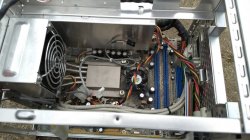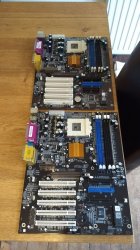Indeed... As someone who got to experience dual-slot 1 system (even if it was for a day or two), I have to say I'm seriously disappointed with the performance. Not to mention it's only compatible with certain group of selected software and OS, which makes it pretty much useless in the terms of every-day usage or even retro gaming
I even converted my HP Kayak XU800 back to its factory specs, running single 800MHz CPU instead of dual 1000MHz ones. The reason was pretty simple, the system was overheating and consuming way too much power, and yet I didn't see any noticeable improvements in the terms of speed & performance.
I haven't tested it yet really myself extensively... the only multi-socket systems I've ever owned are my big 4-P3 dell, and it won't utilize any sort of "3D video card" what so ever, only the onboard video. So I can't test gaming on it, sadly. Except maybe a Voodoo2 SLI might work. But in theory any game designed for multi-core as modernish games from 2005 -> forward should use it all fine, and WindowsXP supports dual cpu and treats it just like any dual core computer. It's probably more of you were just playing old single-core based games actually.
I own a dual-Pentium-Pro motherboard I bought summer 2016 but haven't been able to get it running yet.. no money for cpu's and I have to spend the money on other stuff. I did pick up a 550 watt power supply recently from Antec that has a hefty +5V rail, (a requirement for old pre-p4-connector systems). Modern power supplies can't handle those systems, the +5v rail on modern units is usually like 20 amps or less, probably not enough for a pair of P-Pro's.
A little bit of info for you. The very first dual core CPU's from Intel actually were two single core cpu's slapped on a cpu package together with an inter-connect, and technically -WERE- "2 cpu systems" and sold to the masses as "A dual core cpu!".
EDIT: An image of the first dual core CPU's from Intel, Pentium4 era Pentium-D chip:

Last edited:





 Basically, a full multimedia system, this is the system that's paired with Genius HF2020 speakers!
Basically, a full multimedia system, this is the system that's paired with Genius HF2020 speakers!



























